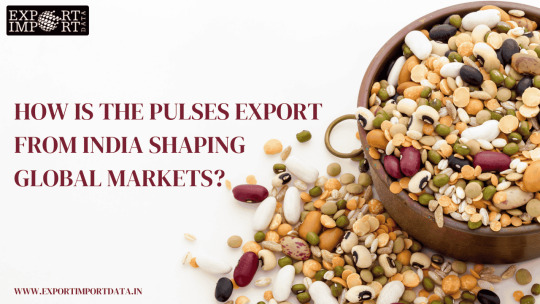#toor dal hsn code
Explore tagged Tumblr posts
Text
How Is the Pulses Export from India Shaping Global Markets?

India is one of the largest producers and exporters of pulses, supplying various types of lentils and beans to countries worldwide. But how does the pulses export from India work? What are the essential regulations, HS codes, and leading pulses exporters in India? Let’s explore the details in this informative article.
1. What Is the Current Scenario of Pulses Export from India?
India has a well-established pulses market, exporting different varieties of pulses, including toor dal, green mung beans, and black matpe. The demand for export pulses from India has increased due to global dietary shifts, with people choosing plant-based protein sources.
Key Trends in India's Pulses Export Market:
India exports pulses to over 100 countries, including the UAE, Bangladesh, Sri Lanka, and the USA.
The export data of pulses from India indicates steady growth in exports over the past five years.
Government policies influence the import and export of pulses in India, especially during shortages.
2. What Are the HS Codes for Pulses Export from India?
To facilitate trade, pulses have specific HS codes (Harmonized System Codes) that categorize them. These codes are essential for identifying products in international markets.
Major HS Codes for Pulses:
Pulses Type HS Code Pulses (general category)210Toor Dal880 / 110Green Mung Beans40Black Matpe50
Why Are HS Codes Important?
They help in customs clearance for pulses exporters in India.
They ensure accurate taxation and duty calculations.
They prevent fraudulent trade practices in export pulses from India.
3. Who Are the Leading Pulses Exporters in India?
India has several established pulses exporters catering to international markets. These Indian pulses exporters follow quality standards to meet global demand.
Top Features of Reliable Pulses Exporters:
✅ FSSAI and APEDA certification for food exports. ✅ Compliance with global trade standards. ✅ Consistent supply and competitive pricing. ✅ Strong international trade networks.
Major Pulses Exporting Companies in India:
Adani Wilmar – A top exporter with a vast global network.
Laxmi Agro Products – Specializes in toor dal and green mung beans.
Shri Lal Mahal – Offers a variety of lentils and pulses for export.
If you’re looking for pulses exporters in India, consider those with verified certifications and positive export records.
4. What Are the Challenges and Opportunities in Pulses Export from India?
Challenges:
Fluctuating Government Policies: The Indian government often imposes export restrictions to stabilize domestic prices.
Climate Conditions: Poor monsoons can reduce crop yield, affecting export data of pulses from India.
Global Competition: Countries like Canada and Australia also export pulses, creating competition.
Opportunities:
Increasing Global Demand: More countries are importing pulses for plant-based protein diets.
Expanding Export Markets: African and Middle Eastern countries are emerging as key buyers.
Organic and Premium Pulses: There is a growing demand for organic pulses, providing new business opportunities for Indian pulses exporters.
5. How Can Importers and Exporters Benefit from India’s Pulses Market?
For Importers:
India provides a variety of pulses at competitive prices.
Strong trade policies ensure quality and safety.
Access to bulk orders through trusted pulses exporters.
For Exporters:
Government incentives support the export pulses from India.
Diversified markets reduce trade risks.
A growing focus on organic pulses opens premium markets.
Conclusion
The pulses export from India is a crucial part of global trade, meeting the growing demand for plant-based protein. With well-established pulses exporters in India, structured pulses HS codes, and evolving market trends, the industry has a bright future. Understanding toor dal HS code, green mung beans HS code, and black matpe HS code helps streamline the export process.
Do you have any questions about pulses exports? Drop them in the comments!
FAQs
1. What is the pulses HS code for export from India? The general pulses HS code is 210, but specific pulses have different codes (e.g., toor dal HS code is 880/110, green mung beans HS code is 40, and black matpe HS code is 50).
2. Which countries import pulses from India? Countries like Bangladesh, UAE, Sri Lanka, the USA, and Canada import large quantities of pulses from India.
3. How do I find reliable pulses exporters in India? Look for APEDA-certified Indian pulses exporters with a proven export record and good customer reviews.
4. What are the main challenges in the pulses export business? Challenges include government regulations, climate changes, and global competition. However, India remains a strong player in the pulses export market.
5. Is the pulses export business profitable? Yes! With growing global demand and premium organic pulses markets, the pulses export from India is a profitable industry for exporters.
#pulses export from india#pulses hs code#pulses exporters in india#export pulses from india#toor dal hsn code#toor dal hs code#green mung beans hs code#black matpe hs code#export data of pulses from india#pulses exporters#indian pulses exporters#import and export of pulses in india
0 notes